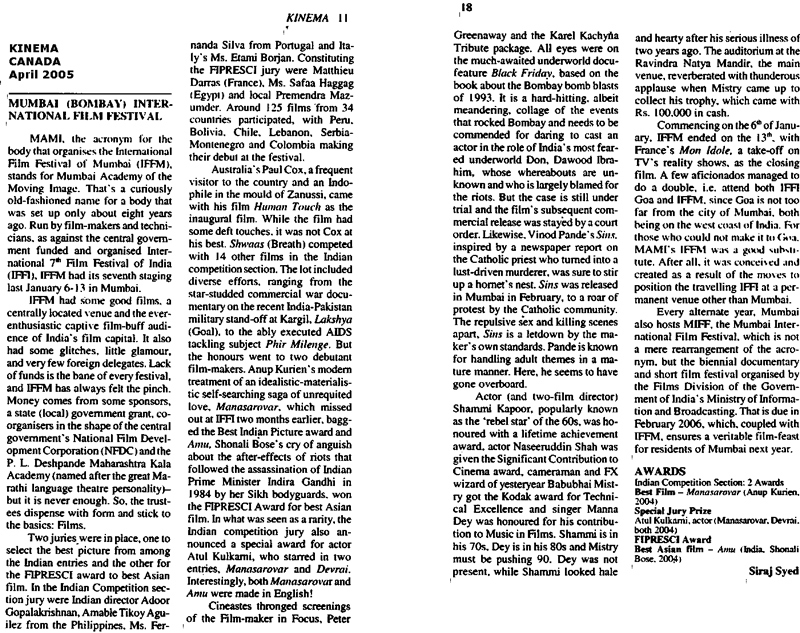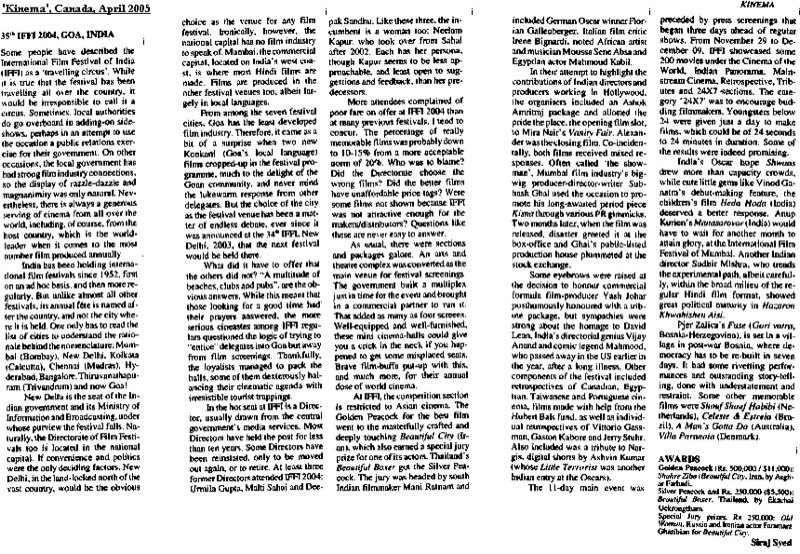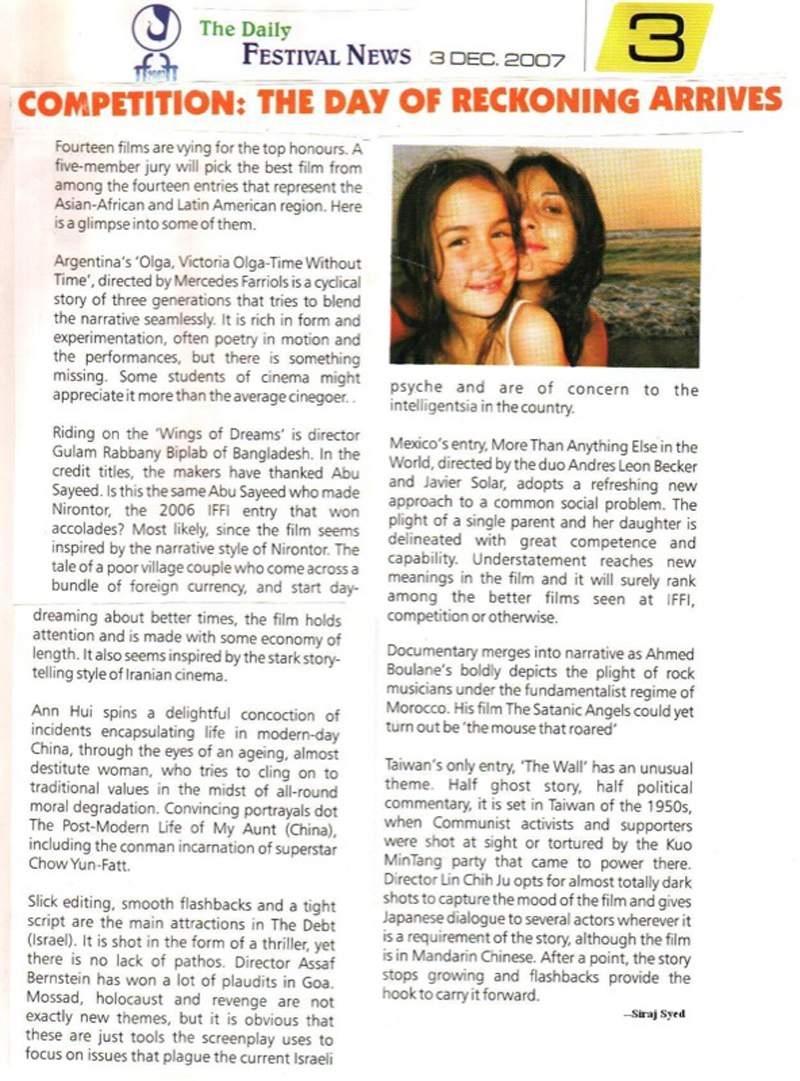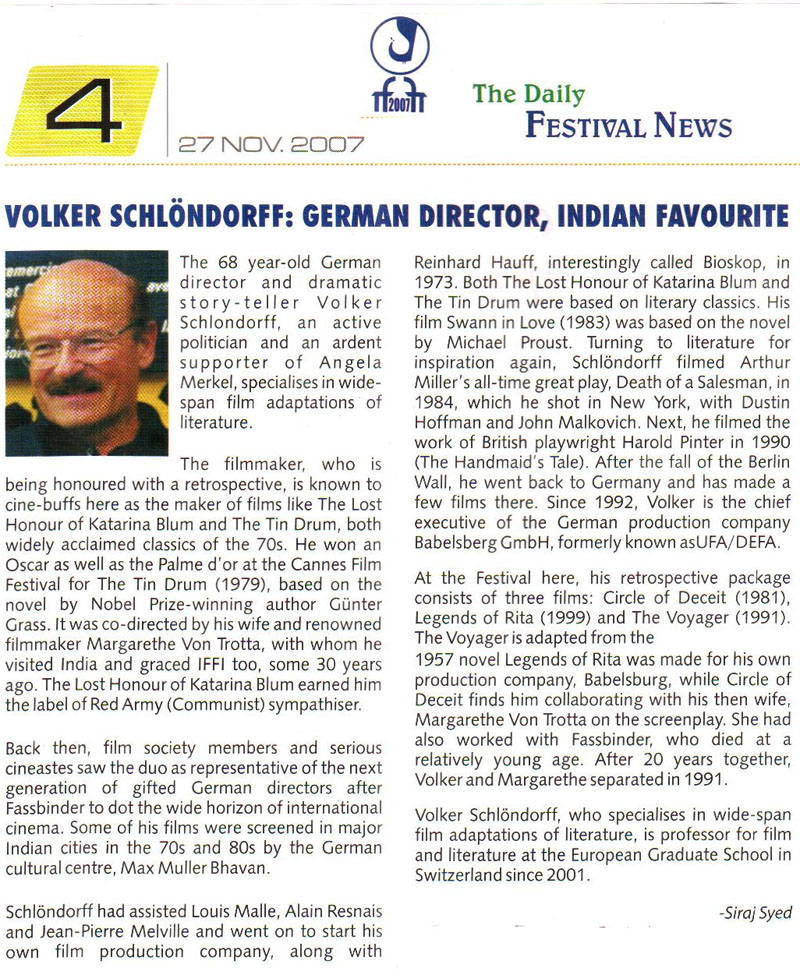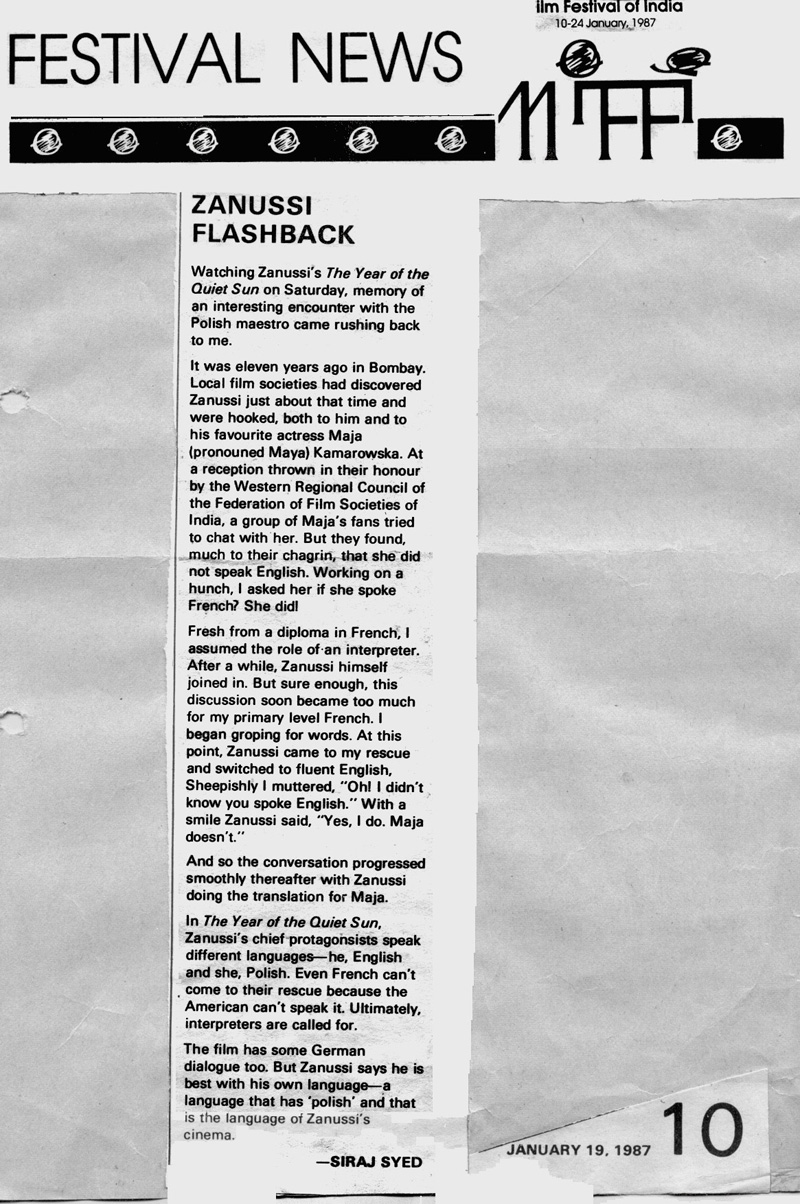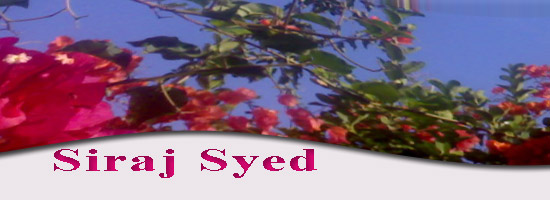|
|
||
|
Pro Tools
FILMFESTIVALS | 24/7 world wide coverageWelcome ! Enjoy the best of both worlds: Film & Festival News, exploring the best of the film festivals community. Launched in 1995, relentlessly connecting films to festivals, documenting and promoting festivals worldwide. Sorry for the disruptions we are working on the platform as of today. For collaboration, editorial contributions, or publicity, please send us an email here. User loginActive Members |
Siraj SyedSiraj Syed is the India Correspondent for FilmFestivals.com and a member of FIPRESCI, the International Federation of Film Critics. He is a Film Festival Correspondent since 1976, Film-critic since 1969 and a Feature-writer since 1970. He is also an acting and dialogue coach. @SirajHSyed  The Hobbit—Battle of the Five Armies, Review: 5 times the fight fest, in 4DX and 3D
The Hobbit—Battle of the Five Armies, Review: 5 times the fight fest, in 4DX and 3D *So snow comes after fire, and even dragons have their endings. ― J.R.R. Tolkien, The Hobbit The film opens where The Hobbit: The Desolation of Smaug left off: the dragon is on his way to attack the town of Esgaroth on the lake. People flee in terror, while Bard the Bowman struggles to escape from prison in order to help fight the dragon. the dwarf king Thorin Oakenshield’s ‘dragon sickness’, the greed of the elven king Thranduil, the desperation of the displaced people of Esgaroth, and the hobbit Bilbo Baggins’s attempts to make peace among them (he steals Arkenstone to use it as a bargaining tool in order to try and avoid the battle of the five armies) the White Council—Gandalf, Saruman, Elrond, and Galadriel—gather to drive Sauron the Necromancer out of his stronghold at Dol Guldur, and learn that he has long been planning to send two enormous armies of orcs to wipe out the elves, dwarves, and men around the mountain kingdom of Erebor. Gandalf recruits some old pals to assist in his escape from the dungeons of Dul Guldur. Along the way, there is a weak attempt at comedy, involving a cowardly lake-man Alfrid (Ryan Gage), who is entrusted with important tasks but ends up finding ways to escape and to steal treasures, even if it involves getting into drag mode to hide himself and his booty. There and Back Again, the initial title of this outing, “…felt like the right name for the second of a two film telling of the quest to reclaim Erebor, when Bilbo’s arrival there, and departure, were both contained within the second film. But with three movies, it suddenly felt misplaced—after all, Bilbo has already arrived “there” in the Desolation of Smaug,” says Peter Jackson, the director and one of the writers. “When we did the première trip late last year, I had a quiet conversation with the studio about the idea of revisiting the title. We decided to keep an open mind until a cut of the film was ready to look at. After viewing the movie, we all agreed there is now one title that feels completely appropriate--The Hobbit: The Battle of the Five Armies.” In such a complex plot, which is reduced to 154 minutes, it would take some level of editing to explain and justify the proceedings. As it happens, there are many pieces of unfinished business, many developments left to the viewers’ imagination, and many questions left unanswered. These include the both the entry and return journey of the central Hobbit, Bilbo. In the epic battle, the moves and counter-moves are difficult to follow, especially as allies and enemies are not distinguished and group after group launches attacks after attacks, inter-cut with other groups doing the same. Also, some parts need audiences to have seen previous episodes to grasp the plot and identify behavior patterns of the characters. Occupational hazard, some might say in defence, but then every film should be complete, even if it means adding flashbacks, text or voice-overs, if the narrative itself is not self-explanatory. Five armies is a good ploy to multiply the action, and means five times the blood and gore, which includes numerous splittings of monster-heads. Having become Lord of the SFX/CGI himself, Jackson does not disappoint one bit. One can quarrel about the choice of subject itself and the necessity of spread the cult of supreme greed and unrestrained, graphic massacre, albeit in a pre-historic, invented world, with the ostensible message of ‘the good will win in the end’. Once you hold back your revulsion and outrage at the prmise, and convince yourself that it is all in the great cause of entertainment, you’ll enjoy the film all the more. Peter Jackson grew up near Wellington, New Zealand. He was given a super 8mm camera by his parents and proceeded to make war movies in the backyard. After early efforts, like James Bond spoof Coldfinger, and (abandoned) feature The Curse of the Gravewalker — shot in Super 8 using a Cinemascope-style lens — Jackson made his feature film debut in 1988, with Bad Taste. Puppet satire Meet the Feebles (1989), Braindead (1992 — retitled Dead Alive for American release) followed. Heavenly Creatures (1994), his first steps into the digital realm, led to him establishing a very basic CGI facility of his own. The Lord of the Rings trilogy was a mammoth success, critically and commercially. Finally, Jackson found himself at the head of a proud Kiwi contingent at the 2004 Academy Awards. With 11 Oscars in the bag, the writer trio of Jackson, Fran Walsh and Philippa Boyens moved from Tolkien into remaking Jackson's beloved King Kong, using many of the creative team that had worked on the Rings trilogy. It won three Oscars (two for sound, one for visual effects), and saw Jackson's direction nominated for a Golden Globe. Their next was an adaptation of the Alice Sebold bestseller The Lovely Bones. And then came the Hobbit series, (Guillermo Del Toro is to the trio in The Battle of the Five Armies), making it a quartet. The 3D is fabulous, with the dragon and its flames leaping at you, the arrows arching along your forehead and the swords often slicing the air right in front of your eyes. Fights have been choreographed with imagination, with the hopping across the crumbling steps making you hold your breath. Production design is award-winning. An all-star cast makes it difficult to ration the scenes proportionately, but you do feel that Bilbo Baggins has been short-changed in the first half of the screen footage. And it a welcome sight to see 92 year-old Sir Christopher Lee, as Saruman the White. The British actor is the only Lord Of The Rings cast member who had ever met Tolkien, and received the author's blessing to play Gandalf in future films. As the title suggests, this is meant to be film about the Hobbit, Bilbo Baggins. British actor Martin Freeman, now 43, acted in a number of British television series before his big break, being cast as Tim Canterbury on the BBC series The Office. Since then, he has become known for roles in films like Love Actually (2003) and The Hobbit series. Freeman has also developed a following for his portrayal of Dr. John Watson opposite Benedict Cumberbatch (as Sherlock Holmes) in the popular British television series, Sherlock (2010). He studied at the Central School of Speech and Drama. In his early career, he performed in several productions at London's National Theatre. In 2005, he appeared in the film adaptation of Douglas Adams's novel, The Hitchhiker's Guide to the Galaxy. Freeman is a delight, impish at times, pensive at others. He is in familiar company as the voice of Smaug/Necromancer, is provided by Benedict Cumberbatch. Technically mastered to sound so much more menacing and hair-raising, he nevertheless strikes the right chords. Ian McKellen is the other grand old man, Gandalf, and it is hard to distinguish him from Saruman, with the flowing white beard and not too distinct persona. Also in cast are Lee Pace, Evangeline Lilly, Richard Armitage, Luke Evans, Orlando Bloom, Cate Blanchett, Manu Bennett, Aidan Turner, Hugo Weaving, James Nesbitt, Graham McTavish, Dean O'Gorman, Billy Connolly, Mikael Persbrandt and Stephen Fry. This review is based on a3D show. Wonder what it is like in 4DX? Rating: ***1/2 Trailer: https://www.youtube.com/watch?v=pKxQjCgYJ7A J.R.R. Tolkien John Ronald Reuel Tolkien (1892-1973) was a major scholar of the English language, specialising in Old and Middle English. Professor of Anglo-Saxon (Old English) at the University of Oxford, he also wrote a number of stories, including most famously The Hobbit (1937) and The Lord of the Rings (1954-1955), which are set in a pre-historic era in an invented version of our world, which he called Middle-earth. “The names of the dwarves in The Hobbit were taken from verses of a very ancient Norse poem called Voluspà.”--J.R.R. Tolkien, The Hobbit. No, this is not the ‘end’! “And there’s also The Hobbit: The Desolation of Smaug, Extended Cut, which we’re in the process of finishing, with over 25 mins of new scenes, all scored with original music composed by Howard Shore.” --Peter Jackson 17.12.2014 | Siraj Syed's blog Cat. : Benedict Cumberbatch Bilbo Baggins Cate Blanchett Christopher Lee elves Gandalf hobbit lord of the rings Martin Freeman Middle earth Necromancer Orc peter jackson Smaug tolkien Hollywood
|
LinksThe Bulletin Board > The Bulletin Board Blog Following News Interview with EFM (Berlin) Director
Interview with IFTA Chairman (AFM)
Interview with Cannes Marche du Film Director
Filmfestivals.com dailies live coverage from > Live from India
Useful links for the indies: > Big files transfer
+ SUBSCRIBE to the weekly Newsletter DealsUser imagesAbout Siraj Syed Syed Siraj Syed Siraj (Siraj Associates) Siraj Syed is a film-critic since 1970 and a Former President of the Freelance Film Journalists' Combine of India.He is the India Correspondent of FilmFestivals.com and a member of FIPRESCI, the international Federation of Film Critics, Munich, GermanySiraj Syed has contributed over 1,015 articles on cinema, international film festivals, conventions, exhibitions, etc., most recently, at IFFI (Goa), MIFF (Mumbai), MFF/MAMI (Mumbai) and CommunicAsia (Singapore). He often edits film festival daily bulletins.He is also an actor and a dubbing artiste. Further, he has been teaching media, acting and dubbing at over 30 institutes in India and Singapore, since 1984.View my profile Send me a message The Editor |




